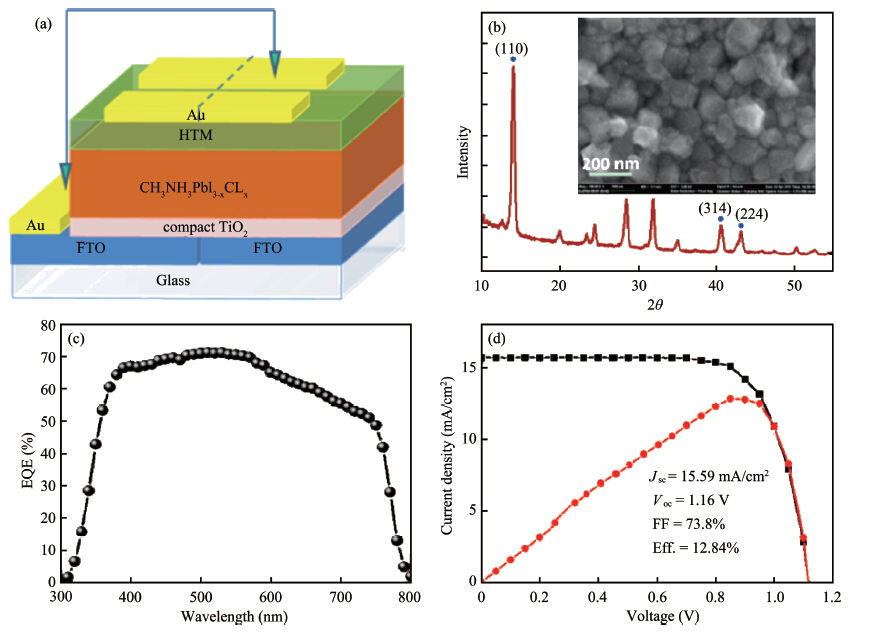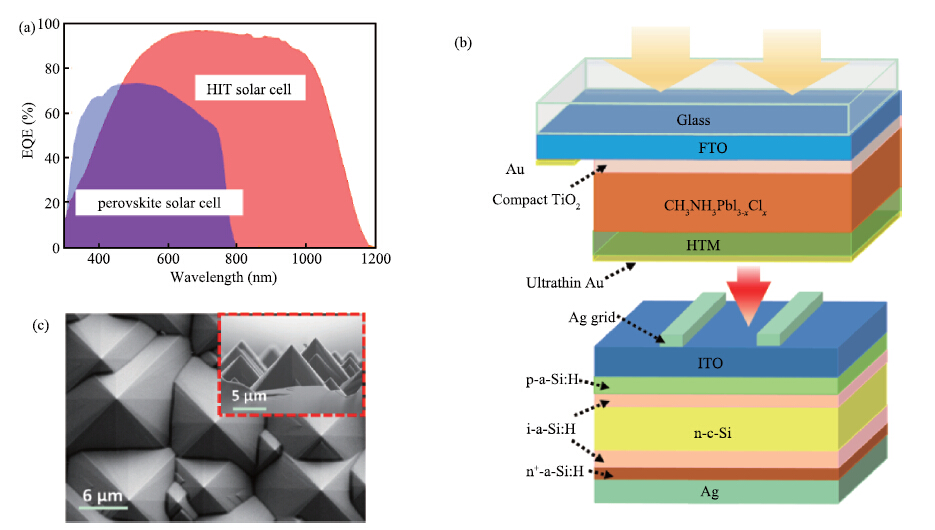| Citation: |
Lin Fan, Fengyou Wang, Junhui Liang, Xin Yao, Jia Fang, Dekun Zhang, Changchun Wei, Ying Zhao, Xiaodan Zhang. Perovskite/silicon-based heterojunction tandem solar cells with 14.8% conversion efficiency via adopting ultrathin Au contact[J]. Journal of Semiconductors, 2017, 38(1): 014003. doi: 10.1088/1674-4926/38/1/014003
****
L Fan, F Y Wang, J H Liang, X Yao, J Fang, D K Zhang, C C Wei, Y Zhao, X D Zhang. Perovskite/silicon-based heterojunction tandem solar cells with 14.8% conversion efficiency via adopting ultrathin Au contact[J]. J. Semicond., 2017, 38(1): 014003. doi: 10.1088/1674-4926/38/1/014003.
|
Perovskite/silicon-based heterojunction tandem solar cells with 14.8% conversion efficiency via adopting ultrathin Au contact
DOI: 10.1088/1674-4926/38/1/014003
More Information
-
Abstract
A rising candidate for upgrading the performance of an established narrow-bandgap solar technology without adding much cost is to construct the tandem solar cells from a crystalline silicon bottom cell and a high open-circuit voltage top cell. Here, we present a four-terminal tandem solar cell architecture consisting of a self-filtered planar architecture perovskite top cell and a silicon heterojunction bottom cell. A transparent ultrathin gold electrode has been used in perovskite solar cells to achieve a semi-transparent device. The transparent ultrathin gold contact could provide a better electrical conductivity and optical reflectance-scattering to maintain the performance of the top cell compared with the traditional metal oxide contact. The four-terminal tandem solar cell yields an efficiency of 14.8%, with contributions of the top (8.98%) and the bottom cell (5.82%), respectively. We also point out that in terms of optical losses, the intermediate contact of self-filtered tandem architecture is the uppermost problem, which has been addressed in this communication, and the results show that reducing the parasitic light absorption and improving the long wavelength range transmittance without scarifying the electrical properties of the intermediate hole contact layer are the key issues towards further improving the efficiency of this architecture device. -
References
[1] Gu J H, Si J L, Wang J X, et al. Indium-tin oxide films obtained by DC magnetron sputtering for improved Si heterojunction solar cell applications. Chin Phys B, 2015, 24:117703 doi: 10.1088/1674-1056/24/11/117703[2] Gharghi M, Fathi E, Kante B, et al. Heterojunction silicon microwire solar cells. Nano Lett, 2012, 12:6278 doi: 10.1021/nl3033813[3] Teplin C W, Lee B G, Fanning T R, et al. Pyramidal light trapping and hydrogen passivation for high-efficiency heteroepitaxial (100) crystal silicon solar cells. Energy Environ Sci, 2012, 5:8193 doi: 10.1039/c2ee21936k[4] Hsiao J C, Chen C H, Lin C C, et al. Effect of hydrogen dilution on the intrinsic a-Si:H film of the heterojunction silicon-based solar cell. J Electrochem Soc, 2011, 158: H876 doi: 10.1149/1.3607981[5] Zhang Q, Zhu M, Liu F, et al. The optimization of interfacial properties of nc-Si:H/c-Si solar cells in hot-wire chemical vapor deposition process. J Mater Sci, 2007, 18:33 http://cn.bing.com/academic/profile?id=1e398751701d8f24e96a758784d8c2b0&encoded=0&v=paper_preview&mkt=zh-cn[6] Kinoshita T, Fujishima D, Yano A, et al. The approaches for high efficiency HIT solar cell with very thin (<100 nm) silicon wafer over 23%. 26th EUPVSC Proceedings, 2011:871 http://cn.bing.com/academic/profile?id=189a15b216aacbdc29d6c51d924e839b&encoded=0&v=paper_preview&mkt=zh-cn[7] Masuko K, Shigematsu M, Hashiguchi T, et al. Achievement of more than 25% conversion efficiency with crystalline silicon heterojunction solar cell. IEEE J Photovoltaics, 2014, 4:1433 doi: 10.1109/JPHOTOV.2014.2352151[8] Richter A, Hermle M, Glunz S W. Reassessment of the limiting efficiency for crystalline silicon solar cells. IEEE J Photovoltaics, 2013, 4:1184 http://cn.bing.com/academic/profile?id=e7c4615c780b89803ff6b849c5ffff97&encoded=0&v=paper_preview&mkt=zh-cn[9] Seo J H, Kim D H, Kwon S H, et al. High efficiency inorganic/organic hybrid tandem solar cells. Adv Mater, 2012, 24:4523 doi: 10.1002/adma.v24.33[10] Barber G D, Hoertz P G, Lee S H A, et al. Utilization of direct and diffuse sunlight in a dye-sensitized solar cell-silicon photovoltaic hybrid concentrator system. J Phys Chem Lett, 2011, 2:581 doi: 10.1021/jz200112m[11] Kitazawa N, Watanabe Y, Nakamura Y. Optical properties of MAPbX3 and their mixed-halide crystals. J Mater Sci, 2002, 37:3583 doi: 10.1023/A%3A1016584519829[12] Green M A, Ho-Baillie A, Snaith H. The emergence of perovskite solar cells. J Nat Photon, 2014, 8:506 doi: 10.1038/nphoton.2014.134[13] Service R F. Turning up the light. Science, 2013, 342:794 doi: 10.1126/science.342.6160.794[14] Service R F. Perovskite solar cells keep on surging. Science, 2014, 344:458 doi: 10.1126/science.344.6183.458[15] McGehee M. Optimizing perovskite semiconductors for tandem solar cells. MRS Spring Meeting, San Francisco CA USA, 2014[16] Löper P, Niesen B, Moon S, et al. Organic-inorganic halide perovskites:perspectives for silicon-based tandem solar cells. IEEE J Photovoltaics, 2014, 4:1545 doi: 10.1109/JPHOTOV.2014.2355421[17] Löper P, Moon S J, de Nicolas S M, et al. Organic-inorganic halide perovskite/crystalline silicon four-terminal tandem solar cells. Phys Chem Chem Phys; 2014, 17:1619 http://cn.bing.com/academic/profile?id=9aedf33ff0a3ae34849d56071816b59a&encoded=0&v=paper_preview&mkt=zh-cn[18] Burschka J, Pellet, Moon S J, et al. Sequential deposition as a route to high-performance perovskite-sensitized solar cells. Nature, 2013, 499:316 doi: 10.1038/nature12340[19] Kim H S, Lee J W, Yantara N, et al. High efficiency solid-state sensitized solar cell-based on submicrometer rutile TiO2 nanorod and CH3NH3PbI3 perovskite sensitizer. Nano Lett, 2013, 13:2412 doi: 10.1021/nl400286w[20] Bi D, Moon S J, Hagmann L, et al. Using a two-step deposition technique to prepare perovskite (CH3NH3PbI3/for thin film solar cells based on ZrO2 and TiO2 mesostructures. RSC Adv, 2013, 3:18762 doi: 10.1039/c3ra43228a[21] Docampo P, Hanusch F C, Stranks S D, et al. Solution depositionconversion for planar heterojunction mixed halide perovskite solar cells. Adv Energy Mater, 2014, 4:1400355 doi: 10.1002/aenm.201400355[22] Conings B, Baeten L, Dobbelaere C D, et al. Perovskite-based hybrid solar cells exceeding 10% efficiency with high reproducibility using a thin film sandwich approach. Adv Mater, 2014, 26:2041 doi: 10.1002/adma.201304803[23] Kim H S, Lee C R, Im J H, et al. Lead Iodide perovskite sensitized all-solid-state submicron thin film mesoscopic solar cell with efficiency exceeding 9%. Sci Rep, 2012, 2:591 https://www.researchgate.net/profile/Jacques-E_Moser/publication/230716542_Lead_iodide_perovskite_sensitized_all-solid-state_submicron_thin_film_mesoscopic_solar_cell_with_efficiency_exceeding_9/links/09e41506f09cb81b07000000.pdf[24] Burschka J, Pellet N, Moon S J, et al. Sequential deposition as a route to high-performance perovskite-sensitized solar cells. Nature, 2013, 499:316 doi: 10.1038/nature12340[25] Tan H, Santbergen R, Smets A H, et al. Light trapping in thin-film silicon solar cells with improved self-assembled silver nanoparticles. Nano Lett, 2012, 12:4070 doi: 10.1021/nl301521z[26] Hagemann H J, Gudat W, Kunz C. Optical constants from the far infrared to the x-ray region:Mg, Al, Cu, Ag, Au, Bi, C, and Al2O3. J Opt Soc Am, 1975, 65:742 doi: 10.1364/JOSA.65.000742[27] Ke W, Fang G, Wang J, et al. Perovskite solar cell with an efficient TiO2 compact film. ACS Appl Mater Interfaces, 2014, 6:15959 doi: 10.1021/am503728d[28] Ding Y, Yao X, Zhang X, et al. Surfactant enhanced surface coverage of CH3NH3PbI3-xClx perovskite for highly efficient mesoscopic solar cells. J Power Sources, 2014, 272:351 doi: 10.1016/j.jpowsour.2014.08.095 -
Proportional views






 DownLoad:
DownLoad:

















